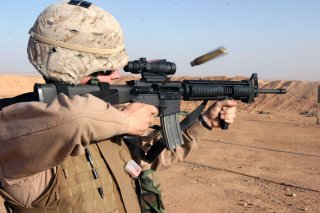The 5 Worst Guns Ever (Colt Made the List, Twice)
The worst of the worst firearms.
Guns are tools meant to address life or death situations, so a poorly designed or manufactured gun often earns particular scorn. The gun world has long memories of particularly bad firearms, many of which sealed the fate of brave soldiers. The rapid pace of firearms development in the nineteenth and twentieth centuries meant that few if any mistakes were repeated, but the memories of these weapons—some with lethal consequences for the owner—linger go on. Here are five of the worst guns ever made.
Chauchat Light Machine Gun
Produced by the Gladiator bicycle company, the French Chauchat machine gun was the one of the very first squad level automatic weapons ever produced. Made for the French and later American armies during World War I, the Chauchat even looked like it was made from bicycle parts, using a great deal of metal tubing nearly identical to that found in bicycle frames. The weapon was capable of only firing three hundred rounds between jams under the best of circumstances, and the trenches of the Great War were far from that, with mud and dirt liable to work its way into the Chauchat’s innards through its many openings and foul the weapon. The gun was poorly designed and often punched the shooter in the eye or cheek if improperly held. Despite these shortcomings the Chauchat soldiered on, mostly because there was nothing to replace it with. While the gun deserves credit as the first of its kind, the fact that all major armies removed it from service at the end of the war speaks for itself. The Chauchat was replaced in U.S. service with the much improved M1918 Browning Automatic Rifle.
Recommended: Smith & Wesson 500: The Gun That Has As Much Firepower As a Rifle
Recommended: Smith & Wesson's .44 Magnum Revolver: Why You Should Fear the 'Dirty Harry' Gun
Recommended: 5 Best Shotguns in the World (Winchester, Remington and Beretta Make the Cut)
Nambu
Imperial Japan, despite its technological prowess at sea and in the air, was a hopeless mess on the ground. One of the least ergonomical pistols ever built, the Nambu was privately purchased by thousands of Imperial Army and Navy officers and became the unofficial pistol of the Japanese military. The Nambu superficially resembled the famous German Luger P-08, with the addition of a safety that could only be operated by the user’s free hand. The double recoil springs, as well as magazine spring, made removing an empty magazine extremely difficult and nearly impossible when the firearm was wet or oily. A weak striker spring often lost power over time and resulted in light primer strikes—something that happened so often the holster had a pouch for a replacement spring. The 8mm cartridge had notoriously poor stopping power and was never used in any other weapon.
Gewehr 41
Although Germany started the war with the bolt action Karabiner 98k, as the fighting dragged on German engineers looked for ways to increase the individual soldier’s rate of fire. One result was the Gewehr 41. The Gewehr 41 was adopted an early gas piston, rotating-bolt rifle operating system that was featured in the M1 Garand. The Garand, however, did a much better job of implementing it. The G41 was expensive to manufacture and the machining involved was complicated. The weapon demanded constant and meticulous maintenance, and its muzzle often fouled. At eleven pounds unloaded it more than two pounds heavier than the 98k, and the weapon was poorly balanced. Although a semi-automatic weapon the integral, nondetachable magazine was slow to load, limiting the rate of fire.
Colt 1855 Revolving Rifle
Nineteenth-century American inventor Samuel Colt created the modern revolver, receiving a patent for an early design in 1836. The revolver system, which promised up to six fast-firing shots before reloading, was quickly adopted as the standard pattern on handguns. An attempt was made to bring revolver-level firepower to the world of rifles, the Colt 1855 Revolving Rifle. Unfortunately for Colt, the weapon was a failure: the open nature of the revolver-cylinder system and the amount of noise it produced was acceptable in a weapon held at arm’s length, but not in a weapon held close to the face. Having the action close to the face was also dangerous in case the weapon suffered a mechanical failure or explosion. Only 1,000 Colt 1855s were built and the entire concept was abandoned by the gun industry.
Colt 2000
The Colt 2000 was the legendary American company’s response to the Austrian Glock pistol—and the worst of the company’s many recent misfires. Despite being developed by noted gun designers Reed Knight Jr. and Eugene Stoner (inventor of the original AR-15 rifle) the Colt 2000 was an embarrassing failure. The actual design of the gun was theoretically quite good, with a polymer frame coupled with metal slide to shed weight, a double stacked magazine that held fifteen rounds and a striker-fired design. Unfortunately the gun had serious reliability problems, with many owners experiencing failure to extract jams, poor accuracy and a safety recall. The Colt 2000 was billed as a gun that would dominate the world of twenty-first-century handguns, but the gun lasted only four years on the U.S. market, from 1991 to its cancellation in 1994.
Kyle Mizokami is a defense and national-security writer based in San Francisco who has appeared in the Diplomat, Foreign Policy, War is Boring and the Daily Beast. In 2009, he cofounded the defense and security blog Japan Security Watch. You can follow him on Twitter: @KyleMizokami.
Image: Wikimedia Commons.

